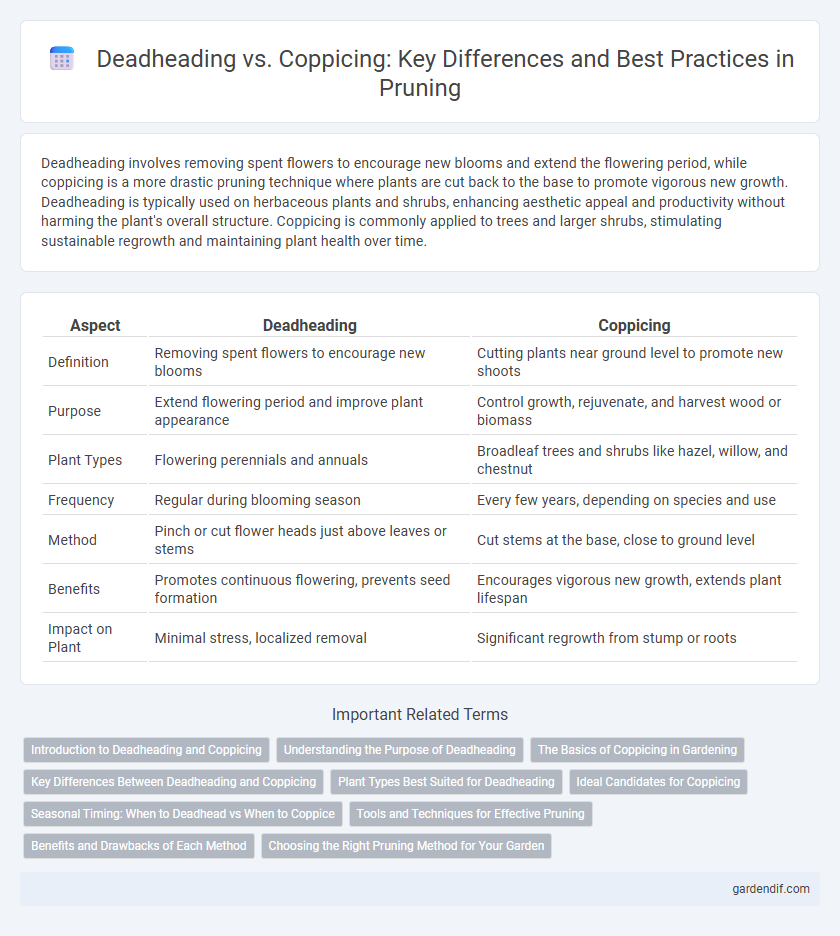
Deadheading vs coppicing Illustration
Deadheading involves removing spent flowers to encourage new blooms and extend the flowering period, while coppicing is a more drastic pruning technique where plants are cut back to the base to promote vigorous new growth. Deadheading is typically used on herbaceous plants and shrubs, enhancing aesthetic appeal and productivity without harming the plant's overall structure. Coppicing is commonly applied to trees and larger shrubs, stimulating sustainable regrowth and maintaining plant health over time.
Table of Comparison
| Aspect | Deadheading | Coppicing |
|---|---|---|
| Definition | Removing spent flowers to encourage new blooms | Cutting plants near ground level to promote new shoots |
| Purpose | Extend flowering period and improve plant appearance | Control growth, rejuvenate, and harvest wood or biomass |
| Plant Types | Flowering perennials and annuals | Broadleaf trees and shrubs like hazel, willow, and chestnut |
| Frequency | Regular during blooming season | Every few years, depending on species and use |
| Method | Pinch or cut flower heads just above leaves or stems | Cut stems at the base, close to ground level |
| Benefits | Promotes continuous flowering, prevents seed formation | Encourages vigorous new growth, extends plant lifespan |
| Impact on Plant | Minimal stress, localized removal | Significant regrowth from stump or roots |
Introduction to Deadheading and Coppicing
Deadheading involves the selective removal of spent flowers to promote further blooming and maintain plant health, commonly used in garden maintenance for flowering plants. Coppicing is a traditional woodland management technique where trees or shrubs are cut back to ground level to stimulate new growth from the base, enhancing sustainable timber production. Both methods optimize plant vitality but differ in their application and desired outcomes in horticulture and forestry.
Understanding the Purpose of Deadheading
Deadheading removes spent flowers to encourage continuous blooming and redirect the plant's energy toward new growth rather than seed production. This practice improves the plant's aesthetic appeal and prolongs flowering periods, critical for annuals and perennials aiming to maximize bloom output. Unlike coppicing, which involves cutting back woody stems to stimulate regeneration, deadheading specifically targets faded blooms to maintain plant vigor and flowering efficiency.
The Basics of Coppicing in Gardening
Coppicing is a traditional pruning technique where trees or shrubs are cut back to the stump or ground level to encourage vigorous new growth. Unlike deadheading, which involves removing spent flowers to promote blooming, coppicing rejuvenates plants by stimulating the development of strong, healthy shoots from the base. This method is particularly effective for species like hazel, willow, and alder, supporting sustainable wood production and garden vitality.
Key Differences Between Deadheading and Coppicing
Deadheading involves the selective removal of spent flowers to encourage continuous blooming and improve aesthetic appeal, primarily applied to annuals and perennials. Coppicing is a traditional woodland management technique where trees or shrubs are cut back to ground level to promote vigorous new growth and sustainable timber production. Key differences include deadheading targeting flower removal without damaging main stems, while coppicing involves cutting entire stems near the base for regeneration purposes.
Plant Types Best Suited for Deadheading
Deadheading is best suited for flowering plants such as roses, marigolds, and petunias that benefit from the removal of spent blooms to encourage continuous flowering and improve plant vigor. In contrast, coppicing is ideal for woody shrubs and trees like willows, hazels, and certain fruit trees that respond to severe cutting back by producing new shoots from the base. Deadheading supports ornamental garden plants, while coppicing caters to plants grown for wood or rejuvenation purposes.
Ideal Candidates for Coppicing
Ideal candidates for coppicing include deciduous trees and shrubs such as willow, hazel, and ash, which respond well to being cut back to their base, promoting vigorous regrowth. Coppicing is especially effective on species with strong regenerative abilities, providing sustainable wood or foliage harvest. Unlike deadheading, which targets flowering plants to prolong blooms, coppicing focuses on rejuvenating woody plants and managing growth cycles.
Seasonal Timing: When to Deadhead vs When to Coppice
Deadheading is typically performed during the growing season, from spring to late summer, to encourage continuous blooming and prevent seed formation. Coppicing is best done during the dormant season, usually in late winter or early spring, to promote vigorous regrowth and maintain plant structure. Understanding the optimal seasonal timing for deadheading and coppicing ensures healthier plants and maximizes flowering potential.
Tools and Techniques for Effective Pruning
Deadheading involves using hand pruners or garden scissors to remove spent flowers, targeting precise cuts to encourage continuous blooming. Coppicing requires sharp loppers or pruning saws to cut stems close to the base, promoting vigorous regrowth from the root system. Proper sterilization of tools and angled cuts are essential techniques to prevent disease and enhance plant recovery during both pruning methods.
Benefits and Drawbacks of Each Method
Deadheading promotes continuous blooming by removing spent flowers and encourages new bud formation, but it requires frequent maintenance and may not rejuvenate older plants. Coppicing stimulates vigorous regrowth from the base, improving overall plant health and longevity, yet it can lead to temporary aesthetic loss and reduced flowering in the short term. Both methods enhance plant vitality but differ in their application frequency, impact on appearance, and suitability for various species.
Choosing the Right Pruning Method for Your Garden
Selecting the appropriate pruning method depends on the plant species and desired garden outcome. Deadheading promotes continuous blooming by removing spent flowers, enhancing aesthetics for flowering perennials and annuals. Coppicing revives woody plants by cutting them close to the base, encouraging vigorous regrowth and extending the life of shrubs and trees.
Deadheading vs coppicing Infographic

 gardendif.com
gardendif.com